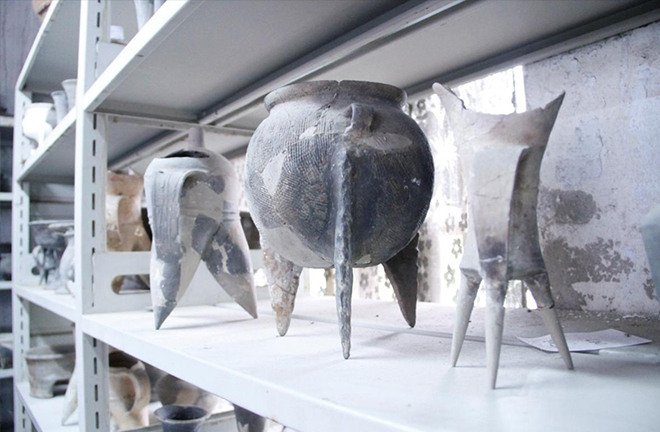Archaeologists reproduce Xia culture

Pottery unearthed from the Erlitou site in Yanshi, Luoyang, Henan Province Photo: Zhang Jie/CSST
Archaeologists have dedicated themselves to the exploration of the Xia (c. 21st century–16th century BCE) culture, a key period in the origin of early dynastic states in China. From the Xia-Shang-Zhou Chronology Project initiated in the mid-1990s, the Project for Tracing Chinese Civilization Origins in the early 21st century, to the Xia culture research program included in the Archaeological China project in 2021, fruitful archaeological results have allowed a deeper understanding of the Xia culture.
Development stages
In the summer of 1959, archaeologist Xu Xusheng and his team set off in search of the ancient “Xia ruins.” Guided by textual records, he conducted extensive investigations across multiple sites in Dengfeng, Yuzhou, Gongyi, Yanshi, and other places in Henan Province. The most significant outcome of this endeavor was the discovery of the Erlitou site in Yanshi, which marked the beginning of Xia cultural archaeology. In the 1970s, archaeologist Zou Heng concluded that the Erlitou culture is indeed part of the Xia culture, a finding that has been substantiated by subsequent archaeological discoveries. Over the course of more than 50 years, extensive archaeological fieldwork and unwavering scholarly dedication have yielded research findings centered around the Erlitou site, providing a robust archaeological foundation for the exploration of the Xia culture.
Wang Zhenzhong, a Member of the Chinese Academy of Social Sciences (CASS), observed three milestones in the century-long journey of Xia culture research. In 1923, historian Gu Jiegang proposed the “Stratification Theorem” as a means to explain the formation of ancient Chinese history. A conference held at the Wangchenggang site in Gaocheng, Dengfeng in 1977 represents another milestone. At present, the Party and state attach great importance to the study of the Xia culture, especially important instructions given by General Secretary of the CPC Central Committee Xi Jinping in recent years, propelling Xia cultural research to its third peak.
According to the Project for Tracing Chinese Civilization Origins, the foundations of Chinese civilization were laid 10,000 years ago; civilization first emerged 8,000 years ago; its development accelerated 6,000 years ago; it entered into the stage of civilized society more than 5,000 years ago; the Central Plains emerged as a powerful region 4,300 years ago; the first dynasty was founded 4,000 years ago; power held by royal families was consolidated 3,000 years ago; and a unified multi-ethnic state was created 2,200 years ago. The establishment of the Xia Dynasty took place during the key period around 4,000 years ago.
According to CASS Member Wang Wei, the discovery of over 10 large urban sites in the southeastern foothills of Songshan Mountain signifies a new phase in Chinese civilization, with the Central Plains becoming the focal point during this period. The Erlitou site, dating back approximately 3,800 to 3,500 years ago, stands as the largest urban site of its time in China. Located in the Yiluo River basin, which corresponds to the central region mentioned in Xia historical records, the Erlitou site provides evidence of the increasing strength of the Xia Dynasty during its later stages, gradually establishing its leading position in the Central Plains region.
Deepening understanding
Since the beginning of Xia culture research, there has been ongoing debate among scholars regarding the nature of certain key sites and their connection with the Xia culture. However, with the successive discovery of myriad sites and the identification of their historical sequences, not only have the features of the Xia culture been continuously enriched, but consensus has also been reached on previously disputed issues. For example, the small city ruins of the Shang city in Yanshi put an end to the argument that Erlitou is the site of Bo, the first capital of Shang (c. 16th century–11th century BCE). The discovery of the Xiaoshuangqiao site in Zhengzhou, Henan, resolved the debate over whether the Shang city in Zhengzhou is the location of Ao (a capital of middle-staged Shang).
The culture of Erlitou is mainly the late Xia culture, and the culture of Erligang in Zhengzhou is the early Shang culture, said Yuan Guangkuo, a professor from the School of History at Capital Normal University. These views have gradually gained recognition within academic circles. Current research on Xia is generally based on the understanding that Erlitou was the capital of the late Xia. There are obvious differences in the archaeological remains of the Xia and Shang cultures. Erlitou palace lies in the center, while major buildings in the capital of Shang are located in the northeast to some extent. The Erlitou culture worshipped dragons, while the Erligang culture worshipped tigers.
The “Archaeological China” project centers on such key issues as the origin of human beings, agriculture, civilization, and the development of a unified multi-ethnic country. Within this project, 18 major projects have been planned, including the Xia culture research program.
Since its launch, a series of new advancements have been made on the Xia culture, said Liu Haiwang, president of Henan Provincial Institute of Cultural Heritage and Archaeology. The large rammed earth foundation in the northern part of the large city ruins in the Wangchenggang site confirms the central position of the site in the Yinghe River basin and the emergence of an “embryonic state organization” around the Songshan region. The discovery of large sacrificial remains and high class ritual pottery and jade artifacts confirmed the importance of the Wadian site in Yuzhou, Henan. The eastern moat of the Guchengzhai site in Xinmi, Henan reflects the progress of urban planning and civil engineering techniques at that time. The study of the Erlitou site, including the examination of its cross-shaped road and other settlements, holds significant importance in bringing the vibrant scenes of the Xia culture to life.
Edited by YANG LANLAN
